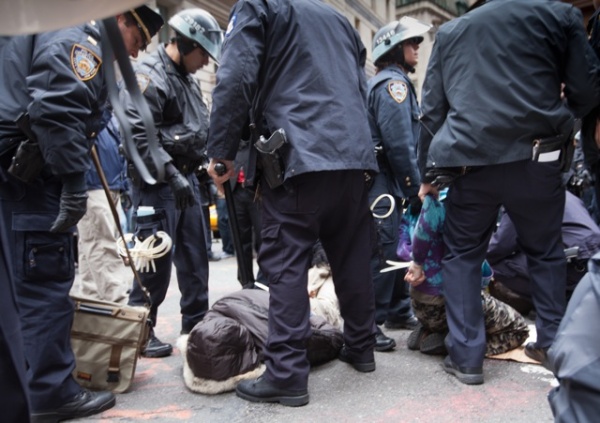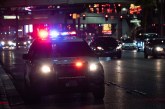
While UC Davis and the Davis community patiently await the findings from the report investigating the November 18 pepper spraying of students on the Quad on the UC Davis campus, a report emerged last week that threw gasoline on the situation at Berkeley.
The author himself acknowledged that his findings are controversial, while protesters dismissed the report, stating: “This is isn’t an analysis, it’s propaganda. It sounds like a tactical handbook for warfare against students.”
Jeff Young, Assistant Chief of Police at the UCLA Police Department, in a report written to Mitch Celaya, UC Berkeley’s Chief of Police, acknowledged that “some of these findings will be controversial from the start. This is unavoidable. This is based on the fact that there is no way to reconcile the divergent and passionately held beliefs of the groups of the UC Berkeley community representative of the people I interviewed.”
He also noted, “All parties involved in this event have a share of the responsibility in how tragically it ended and the devastation to the relationships that still linger to this day. There were misjudgments on all sides.”
Furthermore, “Many were inevitable due to the built-in lack of communications between key organizers and the officials from campus administration and the police department.”
He writes, “Protestors, beginning at the 3:00 demonstration, expected to commit their acts of civil disobedience and then be arrested.”
However, “The police had no intention of making mass arrests. Their goal was to prevent the establishment of an encampment or to dismantle any tents that were erected.”
He noted, “Neither party knew the others’ intentions. The traditional relationships and information-sharing systems were not in play for this event. This fact alone probably doomed it for tragedy.”
All of this seems rather reasonable. However, Mr. Young admonishes UC Berkeley’s Chancellor Robert Birgeneau for prohibiting the use of pepper spray – a move he later said was prescient in light of what happened at the UC Davis campus.
He would tell faculty, “Unfortunately, we did not at the same time discuss the use of the baton.”
However, it was later discovered in emails released by the ACLU that he had responded to news of the use of the batons: “This is really unfortunate… However, our policies are absolutely clear. Obviously, this group wanted exactly such a confrontation.”
“It is critical that we do not back down on our no encampment policy,” the chancellor wrote later. “Otherwise, we will end up in Quan land.”
Mr. Young would admonish the chancellor writing, “Removing any available force options that officers are equipped for and trained to use, prior to deployment, limited the police response options and was inappropriate.”
He continued: “By receiving an outright ban on the use of OC spray, officers were limited to few force options. They could have stood there and done nothing, retreated or used their batons, the action taken. Having such a limited number of options is inappropriate for crowd management and takes away several very effective options that most of the officers are trained to use.”
Most notably he suggested that the use of pepper spray would be “the most appropriate for this situation.”
“This would have been especially effective at the most contentious point of conflict during the afternoon protest. A few focused applications on the crowd that blocked the officers near the row of bushes would likely have cleared that area very quickly, with few additional baton strikes,” he wrote.
Given what happened at the UC Davis campus, that suggestion probably will not go over well. But the two situations were very different, with the UC Davis protesters largely passively seated when the pepper spray was applied.
A spokesperson for the university, Janet Gilmore responded that while the report raises “important issues…regarding pepper spray, there are different points of view regarding (its) use,”
UC Berkeley Police Chief Mitch Celaya cited advantages and disadvantages to the use of pepper spray. “The biggest problem is cross contamination because it spreads quickly through the air and doesn’t allow officers to target only the person not cooperating with police.”
“The advantage of pepper spray is you don’t typically get injuries. It makes people run away or stop what they are doing,” said Chief Celaya.
On the other hand he said that a baton is better for crowd control. “With the baton, I can target individuals. I have some control of where I am directing my baton strike. There are no cross contamination issues.”
Despite being critical of the denial of the use of OC spray, in general he found police actions “in compliance with policies and procedures.”
“The videos that I reviewed did not confirm any allegations of excessive uses of force on the part of UCPD personnel. The crowd control techniques used, specifically the use of baton strikes and jabs, were within current UCPD policies,” he writes.
He notes, “The protestors can be seen with interlocked arms, tensing their muscles (granted, a natural reaction to a baton strike), grabbing at officers’ batons and moving to block officers from going around the crowd. By definitions previously discussed, these actions are active resistance.”
He adds, “The videos viewed do not show any intentional baton blows to prohibited parts of the protestors’ body.”
The full report can be read here.
—David M. Greenwald reporting






The real issue is not whether the actions of the UC Berkeley police were in compliance with UCPD policies, but whether UCPD polices were in compliance with state and federal law.
Point taken, Grad Student, your Master’s Degree is hereby awarded. Better yet, did the actions taken comply with policy AND law. Presumably, they should be compatible.
An assistant police chief calling out a university administrator, now that is perhaps the most remarkable part of this report. I wonder if he ever will become a campus police chief. With political courage like that, I sure hope so.
In law enforcement discussions transcending decades, the irony has not been lost among us that the use of the crude and potentially lethal baton is more legally defensible than the reputed non-lethal weapon, chemical spray.
“Failure to communicate” is a standard response to reports such as this. Let’s follow that line of thinking and picture a police chief saying to a campus administrator, “Tell me exactly what you want, give it to me in writing, and define the parameters of the force options that you approve.” Now, that is effective and responsible communication in crisis planning. One can speculate what it has never occurred before, to my knowledge at least.
“Protestors, beginning at the 3:00 demonstration, expected to commit their acts of civil disobedience and then be arrested.””
” Obviously this group wanted just such a confrontation.”
Quite a contradiction in these two sentences. I would agree that at least some of the protesters wanted to be arrested. I sincerely doubt that any of them wanted to be on the receiving end of a baton.
In my protest experience, protesters fall into different categories with different degree of motivation and behaviors:
1) The organizers, these come with a wide variety of experience and skills sets. Note the difference between the out comes of the Berkeley and
Pepper spray protests, largely uncommunicated, disorganized and conducted largely by kids who barely have the know how to cover up in the
face of imminent spraying as compared with the effectiveness of the silence as Chancellor Katehi walked to her car.
2) The truly committed peaceful protester whose goal is to draw attention, frequently with arrest as the goal
3) The involved protester, who is truly committed to the cause, but for whatever reason ( for example child rearing responsibilities) does not feel
She can risk arrest. These are the people who may push it a little but will ultimately disperse when directly ordered to do so.
4) The casual protester who may or may not favor the actions of those more dedicated but will show up for support or just plain curiosity
5) Finally there is another category that we have not seen here in these protests but that some feel are lurking at every protest, and those are the
Violent fringe.
One problem I am seeing in the posts about the protest is that some do not seem to make any differentiation between these groups. While this is fine on a blog, where no one has the potential for being hurt, I do not think it is fine for our police to behave in the same fashion which is what I believe is exactly what we saw in the pepper spray incident. While the police may or may not have felt intimidated by the preceding chants and encircling by some students, they were not being intimidated by those sitting on the path. Yet those were the ones who were sprayed.
I do not claim to know what motivated those two officers, anger, frustration, annoyance, orders from above ? But from the quality of their expressions, and the manner in which the spray was applied, I can virtually guarantee you that what was motivating Lt Pike was not fear for his or his officers safety from the seated protesters.
@Phil Coleman: The actions of the UC Davis police on Nov. 18, 2011 were probably not in compliance with the Young v. County of Los Angeles federal ruling, so we shouldn’t be surprised to find out that the actions of the UC Berkeley police on Nov. 9, 2011 were also not in complicance with federal law in some way.
Another question, just as interesting, is “Were the protestors in compliance with state and federal laws?”.
@Adam: On Nov. 18th at UC Davis all the tents were already taken down before Pike used the pepper spray. The protesters who were seated were not blocking anyone, because it was in the middle of a very large quad.
Seems to me that all universities/colleges need to take a good hard look at:
1) State/federal law on civil rights; protesting
2) Their own policies, and overhaul them if necessary
3) Common sense
and start developing practice sessions on how best to handle possible protest scenarios in the safest way possible for all concerned, and that includes the safety of protestors; non-protestors; police; bystanders. I’m not saying it is ever an easy situation to deal with protestors, and each situation is unique. However, I get the feeling that this issue of potential protests is not being dealt with by campus police ahead of time in any meaningful way. Regular drills I would think could be quite helpful. Frankly, college campuses are becoming combat zones, instead of bastions of learning, which to my mind is unacceptable…
[quote]“…while protesters dismissed the report, stating: “This is isn’t an analysis, it’s propaganda. It sounds like a tactical handbook for warfare against students.”[/quote]Does it seem at all odd that a bunch of protesters could have spoken these identical words, presumably in unison like singing ‘Happy Birthday’? Who said these fiery words? Did someone?
“Does it seem at all odd that a bunch of protesters could have spoken these identical words”
In days of twitter accounts, facebook pages, and websites, I don’t think it is odd at all.
It looks like the quote comes from Josh Anderson from the March 24, 2012 SF Chronicle article:
http://www.sfgate.com/cgi-bin/article.cgi?f=/c/a/2012/03/24/BABT1NPI6J.DTL
@Grad Student: I thought this discussion was about the happenings at Berkeley.
@Adam: The topics (Nov. 9 and Nov. 18) are necessarily linked together. Both the UC Berkeley and UC Davis police fall under the policies of the entire UC system.